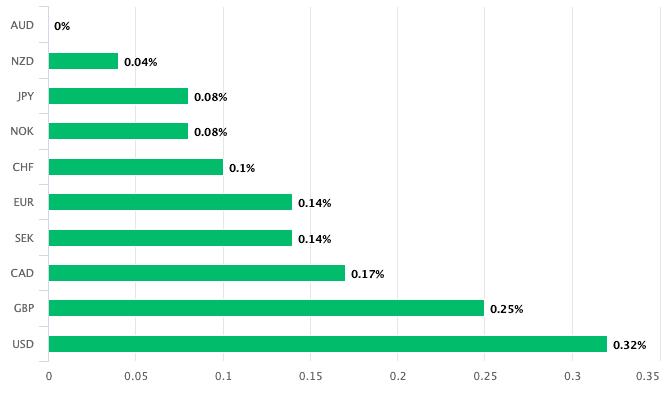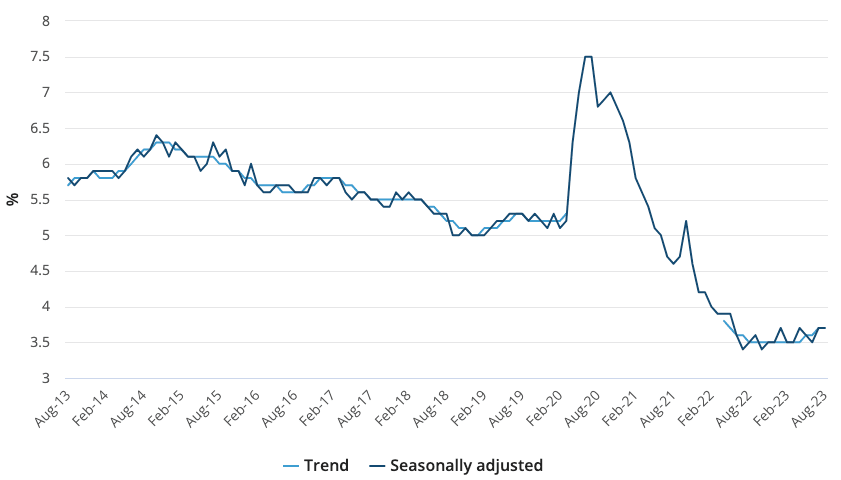Australian Dollar Rebound Boosted by Jobs Report
- Written by: Sam Coventry
-

Image © Adobe Images
The Australian Dollar's month-long rebound against the Pound, Euro and U.S. Dollar received a domestic boost when official data showed a sharp uplift in employment in August that put the market on alert for another interest rate hike at the Reserve Bank of Australia (RBA).
The ABS said 64.9K people entered employment in August, a figure that far exceeds the 23K the market was expecting and provides the kind of positive surprise that can have an impact on currency markets.
Furthermore, the number of Australians who have entered the labour force rose, taking the country's participation rate to a record high 67%, exceeding the 66.7% the market was expecting. The head of the ABS, Bjorn Jarvis said this reflects a tight labour market.
The unemployment rate remained steady at 3.7%, anchoring it near historical lows.
"Admittedly, much of the job growth in August was due to an increase in part-time employment. Nevertheless, the Australian labor market still seems to be proving more robust than suspected in recent months," says Michael Pfister, an economist at Commerzbank.
The impact on the Australian Dollar was clear with the currency outperforming all its G10 peers as the rebound that has taken place over the course of the past month extended.

Above: AUD performance on the day of the Australian labour market report
The Pound to Australian Dollar exchange rate was a further 0.20% lower on the day at 1.9404 and could be on course to record a seventh consecutive daily decline. At the time of writing, the Australian Dollar-U.S. Dollar exchange rate was up a quarter of a per cent at 0.6436.
Against the Euro, the Aussie unit was up 0.10% at A$1.6629.
"AUD/USD was supported by a strong labour force report overnight," says Kristina Clifton, a strategist at Commonwealth Bank.
Commerzbank's Pfister says the robust data "should play into the RBA's hands. Another rate hike in November is now not all that unlikely, should the labour market remain tight and inflation continues to stay above target."
"If the monthly inflation figures, which will be published at the end of September, also turn out higher than expected, the Aussie should therefore benefit further," he adds.
Above: Australian labour market is running near historically low levels of unemployment
However, economists at Commonwealth Bank say the Australian labour market is becoming "less tight" with the supply of labour lifting and the demand for labour easing.
The implication is that the labour market is set to turn and future prints won't look as constructive for those looking for another RBA interest rate hike.
Indeed, Clifton notes financial markets are still pricing a relatively small chance of an interest rate cut by the end of 2024.
But, "with consumer spending clearly softening we expect rate cuts to get underway in Australia in H1 2024. The eventual pricing of a rate cutting cycle in 2024 will add to the headwinds for AUD," she says.
Adam Boyton, economist at ANZ Bank, says this is a more mixed labour force survey than the headline 64.9k gain in employment suggests.
In particular, the unemployment rate holding at 3.7%, the vast bulk of jobs growth being part‑time, and hours worked falling in the month take the gloss off the impressive headline jobs print.
"Yes, the labour market is still very solid but slack is creeping in," says Boyton. "As a result, there is no change to our RBA view off the back of these data, we see the cash rate on hold at 4.1% for quite some time."












